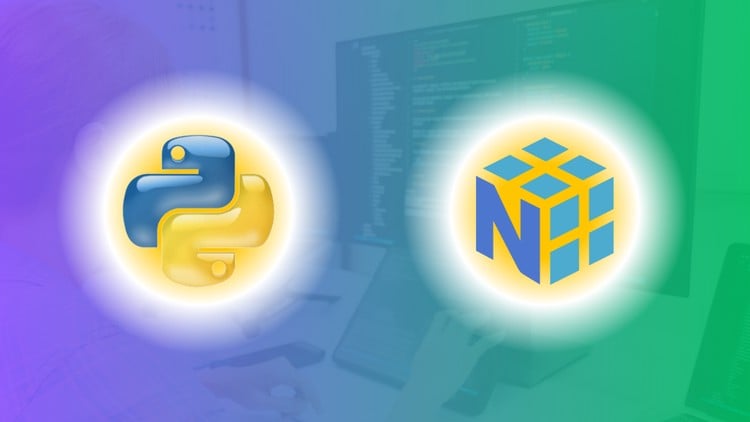
Master NumPy for Data Analysis: Learn Python Techniques for Efficient Data Manipulation and Complex Computations
⏱️ Length: 2.5 total hours
⭐ 4.18/5 rating
👥 18,396 students
🔄 September 2024 update
Add-On Information:
Note➛ Make sure your 𝐔𝐝𝐞𝐦𝐲 cart has only this course you're going to enroll it now, Remove all other courses from the 𝐔𝐝𝐞𝐦𝐲 cart before Enrolling!
- Course Overview
- This course offers a streamlined pathway to understanding and effectively utilizing NumPy, Python’s fundamental library for numerical computing. Designed for aspiring data analysts, scientists, and engineers, it meticulously demystifies array-based programming, which is crucial for handling large datasets with efficiency.
- You will discover how NumPy serves as the bedrock for the entire Python data science ecosystem, enabling lightning-fast operations that pure Python often struggles with. We focus on building a robust conceptual understanding alongside practical application, ensuring you can confidently transition from basic data structures to powerful, vectorized computations.
- Embark on a journey to transform your Python scripting into a high-performance data analysis toolkit, essential for modern data challenges, by mastering techniques for efficient data manipulation and complex computations.
- Requirements / Prerequisites
- A foundational grasp of Python programming concepts, including variables, data types, control flow (loops, conditionals), and functions. While prior experience with advanced libraries is not required, comfort with basic Python syntax is essential.
- Access to a Python installation (e.g., Anaconda distribution) and a development environment like Jupyter Notebooks for interactive practice is recommended.
- A curious mindset and a willingness to engage with mathematical and logical problem-solving are beneficial for optimizing your learning experience.
- Skills Covered / Tools Used
- Efficient Data Structuring: Learn to conceptualize and implement multi-dimensional arrays, optimizing how numerical data is stored and accessed for computationally intensive tasks, moving beyond standard Python lists.
- Vectorized Computation Paradigm: Master the art of applying operations across entire arrays without explicit loops, drastically improving execution speed and code readability—a cornerstone of high-performance computing in Python.
- Data Preparation for Analytics: Acquire advanced techniques for transforming raw numerical data into a format suitable for sophisticated statistical modeling, machine learning algorithms, and advanced scientific simulations.
- Resource-Aware Programming: Gain insights into how NumPy intelligently manages memory and optimizes calculations at a low level, allowing you to write more performant and scalable data processing routines.
- Foundation for Advanced Libraries: Understand how NumPy arrays integrate seamlessly with other key data science libraries like Pandas (for tabular data manipulation), SciPy (for scientific algorithms), and Scikit-learn (for machine learning), establishing a strong base for further specialization.
- Tools Utilized: Python 3.x, the robust NumPy library itself, and typically an interactive coding environment such as Jupyter Notebook or Google Colab for hands-on exercises and practical application.
- Benefits / Outcomes
- Enhanced Data Handling Proficiency: Develop the capability to manipulate, transform, and analyze numerical data with unparalleled speed and efficiency in Python, a critical skill for any data professional.
- Accelerated Code Performance: Significantly reduce computation times for large datasets by leveraging NumPy’s optimized, C-implemented backend, dramatically outperforming standard Python list operations for numerical tasks.
- Gateway to Advanced Data Science: Solidify your understanding of the core numerical computing library, paving the way for easier mastery of complex topics in machine learning, deep learning, and statistical modeling.
- Problem-Solving Acumen: Cultivate a systematic approach to breaking down intricate data problems into elegant, array-based operations, fostering a more intuitive and powerful problem-solving methodology.
- Career Advancement: Equip yourself with an in-demand skill that is fundamental across data analysis, scientific research, financial modeling, and engineering domains, significantly boosting your profile in the competitive tech landscape.
- PROS
- Highly Focused Curriculum: Delivers a concise yet comprehensive introduction to the most critical aspects of NumPy, avoiding unnecessary distractions for efficient learning.
- Practical & Application-Oriented: Emphasizes real-world data analysis scenarios, ensuring learned concepts are immediately applicable in professional contexts.
- Excellent Student Satisfaction: A high rating of 4.18/5, based on feedback from over 18,000 students, reflects a positive and effective learning experience.
- Current & Relevant Content: Recently updated in September 2024, ensuring you learn the latest best practices, features, and an up-to-date approach to NumPy.
- Accessible Entry Point: Ideal for beginners looking to build a strong foundation in numerical Python for data analysis without getting overwhelmed by excessive theoretical detail.
- CONS
- Introductory Depth: Given its 2.5-hour duration, the course provides an excellent foundation but may require further independent study for true “mastery” or highly specialized and advanced NumPy applications.
Learning Tracks: English,Development,Programming Languages
Found It Free? Share It Fast!